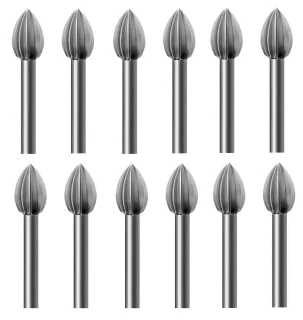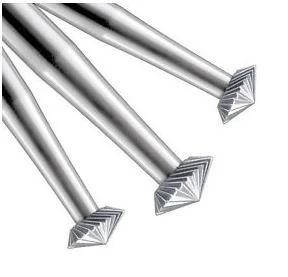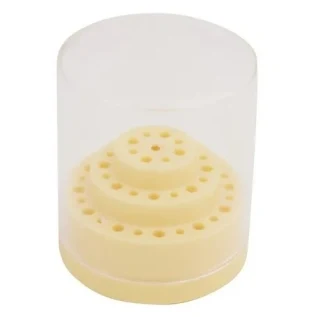These burs are made of "Carbide "& "High Speed Steel" aka "HSS", but they are my loyal "hard-working friends". I take care of them by recutting only the "HSS" burs when necessary.
This topic is related to the previous essay "OUR BURS". You might have seen previous photographs about burs, but these are my selection of wonderful hard-working tools

The range of sizes in this package starts at #003 and finishes off at #014, these sizes are .003 mm's and 0.014mm's
The number#1 relates to a generic SKU numbering system for a Round bur.
Here are a few deep teeth burs that I use for wax-shaping. The problem is that these thin burs collect wax too darned fast and much of my time is wasted in their cleaning.
I use a large 'round and bud' burs to facilitate the wax-carving processes. BTW, the small burs just don't do the carving well.
The closely made teeth burs are great wax collectors, that is why the '3-toothed' round bur is so much better.
This larger bur cuts and lets go of the wax in seconds.
Its basically not the size or shape of the bur, but the depth of the teeth. The bur on the third from the right is the '3-tooth' cutting bur.
This bur pad is one of many in my collection (and well used) as the other styles being shown in the essay are always kept in this pad for these mini-polishing & wire-wheels.
Instead of laying my wide selection of burs all over my bench.
These are kept in an orderly fashion in my wooden bur box.
I estimated that there are over 650 burs in my inventory to be used at any time.
The number '72' on the lid are the number of the burs. Some of these boxes contain 100 burs and still in relatively great condition.
In the top second level are my 4 prized collection of "10.0mm" burs. How much do all of these burs cost me? I don't really care, if I need a bur quickly, then the initial cost is of no importance.
This box is what makes a diamond setter a Diamond Setter. It's not the quantity of burs, but being available at a moments notice to get the job done Fast.
"Burs don't make the setter, it's knowing how to use them is the prime concern"..jpg)
On this particular bur-pad, all of my Emery and Pumice Wheels are ready to be used. The PINK polishing pumice wheel is of 1,000 grit. The Grey and Blue Pumice wheels are only 240 grit. The round tube-shape pumice wheels are used inside the ring.
I only take out the really important burs, as moisture creates rust.
Here are twist-drills, they can be sharpened very easily by getting the tip recut.
On this bur-pad are my inventory of "156C, Under-Cutting burs" also known as 'Bearing Cutters'.
On this pad are all of my round & bud shaped burs of all sizes.
All of the expensive Carbide burs are kept safe from getting damaged. These cannot get repaired if one tooth gets knocked about from hitting or touching a gemstone.
The very large 10.0mm round burs were bought for just one purpose and that is to assist me in a particular setting job. I bought 6 of them in a packet just in case one gets damaged.
Some of these "156C" burs have been damaged and must be discarded, pity.
I am very careful in using these 156C burs, (but sometimes accidents do happen).
These "77B" cup burs are cheap but when I bought them I had to use them to make a tube-setting round. The overall size was the exact size of the setting. My peers were amazed how nice the finished tube looked with not using any files.
These particular strange looking burs were bought just for wax-carving/shaping.
These were originally round-shaped burs, I put them against my bench-grinder and removed half of the bur. These were created to make a seat for a "tube-setting" then the stone was set and the metal was pushed over. The result was that the Cabochon stone was nicely set.
This is a photo of 'before & after' half-round burs.
Here are my favourite "High Speed Steel" (HSS) burs. In a few photos from here, I will explain how they can be repaired.
Although these HSS burs were damaged from touching stones, they can be easily repaired.
These "77B" cup burs need to be modified, why is this? The teeth are not near the edge of the cutting area, I will modify them with no hesitation.
Here is a close-up of my 'half-round' domed-shaped round burs. These are not sold like these, but must be created at your bench, sorry!
You can easily see where the SHARP teeth are ready to be used. Holding the bur at a 90degree angle to the metal, the seat for the stone has been very easily created.
I never buy one or two sets of burs, I'd buy a whole package of 6 of EACH SIZE. You just never know when the next size is needed.
These bud-shaped burs also come in an assortment of 12 of (different) sizes to one package, great idea, eh?
These round burs are also sold in groups of 12 burs to a pack. These are better than buying a '6 bur' package of the size you need.
Here is the answer on how you can carefully repair a HSS (damaged) bur.
I use a 'Separating Disk' to recut EACH TOOTH as shown. These burs ARE and can be very EXPENSIVE.
There is no need to repair the whole side of the bur. That is not warranted, but just recut where the teeth will be starting to do the metal-cutting.
You can see that many of these bur-teeth have been damaged extensively and are beyond repair. Don't waste your precious time in fixing these smaller burs. "Time is MONEY".
These are my answer in the repairing of the HSS burs. This is your cutting tool as I only use a 3/4 inch size of disk. This photo gives you details in what disk you need to buy..jpg)
When you buying burs of one size DON'T. Buy the next size larger and smaller, sometimes it's better to have extra sizes in case the stones come in a variety of sizes.
Here are my own variety of bur sizes as an example of my bur-buying trip.
These mini-burs are relatively inexpensive. I'll buy 2 packages at a time, as running from my bench to my tool supplier, or even going online is a time wasting exercise.
I keep these specialized burs in one wooden box. As these are terribly expensive, if being misused I have a lid that is oiled in case of getting rusty. For example, the 6, '77B Cup' burs have a cost factor of being one of the higher priced burs.
These "77B Cup Burs" need to be modified, this is done by running the edge of the bur on your oil-stone. This will bring the all important 'teeth' to be exposed further while shaping the claws.
This is the 'before & after' views of these burs.
Below are an assortment of views showing my 'family of burs'.
.jpg)

.jpg)
.jpg)
.jpg)
.jpg)
.jpg)
.jpg)
.jpg)

.jpg)


.jpg)

.jpg)

.jpg)

.jpg)
.jpg)
.jpg)
.jpg)
.jpg)
.jpg)
.jpg)
.jpg)
.jpg)
.jpg)
.jpg)
.jpg)
.jpg)
.jpg)
.jpg)
.jpg)



.jpg)
.jpg)

.jpg)
.jpg)
.jpg)
.jpg)


.jpg)

.jpg)
















.jpg)
.jpg)




